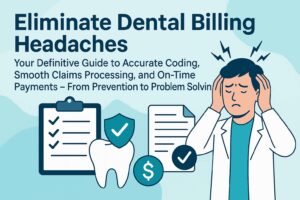
Pros and cons of using a dental clinical notes template

The day-to-day running of a practice can be hectic at times, so many dental professionals use set systems and procedures to streamline their work. After all, less time on the backend means more time on patient care. But occasionally, cutting corners can lead to unwanted risk. This is especially true when it comes to patient records. Taking shortcuts on charting, such as using preestablished templates, can cause more headaches down the road.
When working with dental patients, clinical notes are crucial, and using a clinical notes template helps alleviate the pressure to write everything down. It seems like a no-brainer to use a clinical notes template. It sounds efficient and helpful – but doing so may lead to a few problems if they are not set up properly in your software.
Missing information from clinical notes that you attach to your dental insurance claims can lead to denials. Insurance claim denials then lead to extra claims work for your team and delays in payment from insurance. This is valuable income that you deserve to be collecting.
One Dental Billing has been working with dental teams for over 10 years to submit clean, accurate insurance claims. Through this work, we have seen how dental clinical notes templates can help, but also hinder teams from getting proper reimbursement. Sounds contradictory, right?
Pro’s
- Help you quickly document a ton of pertinent negative findings and other information (i.e. documentation of medical necessity) that is reported for most patients
- Provide for uniform formatting, minimized spelling/ grammatical errors
- Makes charting so simple your assistants can do much of it
- Is easier to read than your handwriting
- Provides for timely documentation
Con’s
- They need to be modified from patient to patient to account for what actually happened – people forget to make needed changes
- Because they look ‘canned’ they often lack the feeling of authenticity and believability
- It is easy to cut and paste the wrong information into the wrong patient record
- Most EDR’s include templates. However, those templates are almost always (grossly) inadequate. They are a framework for you to add to and should never be used ‘as-is’.
- The Pro’s speak for themselves. Let’s discuss how to minimize errors related to these Con’s.
Lastly, it is my experience that documenting non-clinical information, while not clinically relevant, adds believability, a greater sense of reliability, and helps tell the story of what happened. Most patients who file complaints against their dentist never voice their concern to the dentist, so documenting patient behavior, compliance with treatment (or the lack thereof), missed/ late appointments, and et cetera can paint (in advance of a complaint) quite a picture in your favor.
In closing – remember four things:
- ABU (Always Be Updating) your templates.
- ABT (Always Be Training) your staff how to use templates and how to correct inevitable errors.
- TBM (Trust But Monitor) how your templates are used and on an ongoing basis compare your clinical notes against your billing records to verify that one supports the other.
- If you need help set aside your pride and get help right away – waiting can cost your EVERYTHING!
Contact Us
Phone: 908-357-1515
111 Town Square Pl, Suite 1203 Jersey City, NJ 07310












